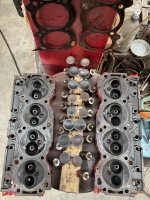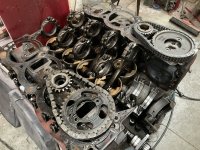Thanks Bob. I see a lot of cooling problems over at V8buick, mostly due to owners insisting on using old worn out, clogged radiators because they are original. Ignition timing also plays a big role in coolant temperatures, and 70's engines used relatively retarded timing at idle with ported vacuum advance, so that tends to heat them up. Aluminum transfers heat much faster than cast iron, so aluminum heads and intake will run cooler to begin with. That is also why you need more compression with aluminum heads. The heat of compression is lost faster than with cast iron heads. You need another full number of compression.
The Griffin radiator I have is a 2 row with 1 1/4" tubes. I bought it back in May of 2001, and it flat out amazes me how well it still cools. The stock 3 core that was in there when I bought my car was in great shape, but it had my iron engine hitting 230* when stuck in summer traffic. The griffin dropped that immediately. I'm amazed that it has lasted me this long, but it has, and is leak free. I also run constant ignition timing at 35*, because the engine loves it, and idles in gear at 750 RPM. My MSD box has a 20* crank retard, so it cranks at 15*, and puts the timing back after 800 RPM. Between all of that, I can get stuck in stop and go traffic on a 90* day, and the coolant temperature never goes over 183*.
Lots of Race guys use the TA Stage 1 and 2 SE and TE heads without a problem. Never seen a problem with warping, but I have seen guys damage the spark plug threads in the head pulling the plugs out with the engine hot. Some of the Racers like to do that to read the plugs after a pass. That is something I have never done, nor will I ever. Bottom line is head flow is the biggest single factor in power production in any engine, and the TA heads will make a HUGE difference even when all else is stock. With 10:1 SCR, and a cam with 230* of intake duration, an aluminum headed BBB will make 500+ HP even with stock exhaust manifolds.
The Griffin radiator I have is a 2 row with 1 1/4" tubes. I bought it back in May of 2001, and it flat out amazes me how well it still cools. The stock 3 core that was in there when I bought my car was in great shape, but it had my iron engine hitting 230* when stuck in summer traffic. The griffin dropped that immediately. I'm amazed that it has lasted me this long, but it has, and is leak free. I also run constant ignition timing at 35*, because the engine loves it, and idles in gear at 750 RPM. My MSD box has a 20* crank retard, so it cranks at 15*, and puts the timing back after 800 RPM. Between all of that, I can get stuck in stop and go traffic on a 90* day, and the coolant temperature never goes over 183*.
Lots of Race guys use the TA Stage 1 and 2 SE and TE heads without a problem. Never seen a problem with warping, but I have seen guys damage the spark plug threads in the head pulling the plugs out with the engine hot. Some of the Racers like to do that to read the plugs after a pass. That is something I have never done, nor will I ever. Bottom line is head flow is the biggest single factor in power production in any engine, and the TA heads will make a HUGE difference even when all else is stock. With 10:1 SCR, and a cam with 230* of intake duration, an aluminum headed BBB will make 500+ HP even with stock exhaust manifolds.




